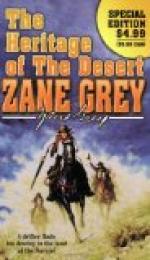Hare recalled what the desert had done to his own nature, how it had bred in him its impulse to fight, to resist, to survive. If he, a stranger of a few years, could be moulded in the flaming furnace of its fiery life, what then must be the cast of August Naab, born on the desert, and sleeping five nights out of seven on the sands for sixty years?
The desert! Hare trembled as he grasped all its meaning. Then he slowly resolved that meaning. There were the measureless distances to narrow the eye and teach restraint; the untrodden trails, the shifting sands, the thorny brakes, the broken lava to pierce the flesh; the heights and depths, unscalable and unplumbed. And over all the sun, red and burning.
The parched plants of the desert fought for life, growing far apart, sending enormous roots deep to pierce the sand and split the rock for moisture, arming every leaf with a barbed thorn or poisoned sap, never thriving and ever thirsting.
The creatures of the desert endured the sun and lived without water, and were at endless war. The hawk had a keener eye than his fellow of more fruitful lands, sharper beak, greater spread of wings, and claws of deeper curve. For him there was little to eat, a rabbit now, a rock-rat then; nature made his swoop like lightning and it never missed its aim. The gaunt wolf never failed in his sure scent, in his silent hunt. The lizard flicked an invisible tongue into the heart of a flower; and the bee he caught stung with a poisoned sting. The battle of life went to the strong.
So the desert trained each of its wild things to survive. No eye of the desert but burned with the flame of the sun. To kill or to escape death--that was the dominant motive. To fight barrenness and heat—that was stern enough, but each creature must fight his fellow.
What then of the men who drifted into the desert and survived? They must of necessity endure the wind and heat, the drouth and famine; they must grow lean and hard, keen-eyed and silent. The weak, the humble, the sacrificing must be winnowed from among them. As each man developed he took on some aspect of the desert—Holderness had the amber clearness of its distances in his eyes, its deceit in his soul; August Naab, the magnificence of the desert-pine in his giant form, its strength in his heart; Snap Naab, the cast of the hawk-beak in his face, its cruelty in his nature. But all shared alike in the common element of survival— ferocity. August Naab had subdued his to the promptings of a Christ-like spirit; yet did not his very energy, his wonderful tirelessness, his will to achieve, his power to resist, partake of that fierceness? Moreover, after many struggles, he too had been overcome by the desert’s call for blood. His mystery was no longer a mystery. Always in those moments of revelation which he disclaimed, he had seen himself as faithful to the desert in the end.




